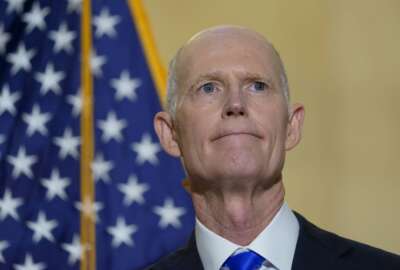Here’s some food for thought, if the current smorgasbord of current events doesn’t already fill up your plate: Midterm elections take place this November.
This year’s elections will determine whether Democrats retain or lose majorities in the House and Senate, and could potentially make it much harder for the Biden administration to make progress on some of its biggest policy goals.
But maybe you can tell it’s a major election year, judging by the Biden administration’s plans to give federal employees a 4.6% pay raise this year, the largest increase of its kind in 15 years.
Much of that pay raise, however, might just go toward the higher price of, well, everything. Given the current rate of inflation, some might think of this pay raise proposal as a super-sized cost of living adjustment.
On the other side of the aisle, Senate Republicans don’t plan to issue an official legislative agenda this year, according to recent reports from multiple outlets.
But that doesn’t mean Republicans aren’t mulling over what the party should do, if they take control.
Consider, for example, Sen. Rick Scott’s (R-Fla.) Rescue America agenda, a 31-plan vision for the party that spends a considerable amount of attention on a major reimagining of the federal workforce.
In the opening pages, Scott cautions that his agenda will be “mocked by Washington insiders and strike fear in the heart of some Republicans.”
“I’ll warn you; this plan is not for the faint of heart,” Scott wrote.
Among its more ambitious plans, the agenda calls for members of Congress and most federal employees to only serve a maximum of 12 years on the job — but makes an exception for feds working in national security.
The plan also calls for shrinking the federal workforce by 25% in five years.
This vision of the federal workforce, as expected, doesn’t sit well with federal employee unions. But at the same time, they don’t expect these ideas will gather momentum in Congress.
Jacqueline Simon, public policy director for the American Federation of Government Employees, said the plan “isn’t a serious idea” for the federal workforce, and doesn’t reflect popular opinion.
“I think it’s based on an assumption that the American public doesn’t understand or appreciate or value [what] federal employees do — but I don’t think that’s true,” Simon said.
Scott’s plan also riffs on some familiar ideas other lawmakers have raised in recent years, including a plan to move most agencies out of the Washington, D.C. metro area “and into the real world.”
The Trump administration put this idea into practice, when it moved the Bureau of Land Management’s headquarters to Grand Junction, Colorado — only for the current administration to anchor the agency back in D.C. and turn the Grand Junction outpost into its “western headquarters.”
Lawmakers in recent years have introduced bills that would relocate more agencies beyond the Beltway, but as it stands, only 14% of the federal workforce live and work in the D.C. metro area.
“This whole idea that the federal government and so-called federal bureaucrats are concentrated in Washington, D.C. is simply not true. The federal workforce is not a bunch of people sitting in cubicles, in government offices in Washington,” Simon said.
Scott’s plan ups the ante, and envisions the federal government selling off “all non-essential government assets, buildings and land,” then using the proceeds to pay down the national debt.
On a much smaller scale, many lawmakers agree the federal government probably has too much office space. That’s why Congress in 2016 passed the Federal Assets Sale and Transfer Act (FASTA), which created a board tasked with selling $7 billion worth of federal real estate over the next six years.
The General Services Administration, however, is still looking for a buyer for many of the properties that a bipartisan board recommended for sale. As of last November, GSA sold three properties under the FASTA process.
Only one of them was an actual building. GSA also sold a parking lot and some excess land.
The plan also calls for “immediately” cutting the IRS funding and workforce in half. The agency, no stranger to doing more with less, would have a hard time stomaching a 50% reduction.
At its current staffing levels, IRS managers at some offices have to decide whether their office will answer phone calls or respond to mail — but don’t have the capacity to do both.
National Treasury Employees Union President Tony Reardon said these proposals would “dramatically remodel the federal workforce,” and severely reduce service to the public.
“We have all seen how underfunded and understaffed agencies impact the ability of agencies to meet their missions. If these dangerous proposals were to become law, they would drastically weaken the federal government’s ability to provide vital resources and services to the American people,” Reardon said.
Scott’s agenda doesn’t just focus on the executive branch. The senator also seeks to make all federal legislation sunset after five years, on the ground that, “if a law is worth keeping, Congress can pass it again.”
That’s a high bar for Congress, which still hasn’t passed a comprehensive spending plan for the current fiscal year, and has passed several short-term continuing resolutions.
Nearly Useless Factoid
By Jonathan Tercasio
The largest known black hole in the universe, Ton 618, has a mass that’s 66 billions larger than that of the sun.
Source: Space.com
Copyright
© 2024 Federal News Network. All rights reserved. This website is not intended for users located within the European Economic Area.
